Understanding the Cell Structure, Metabolism and Growth
Write an illustrated report on cell structure and function, covering topics such as cell characteristics, prokaryotic and eukaryotic cells, cellular metabolism, cell growth and division.
35 Pages6788 Words35 Views
Added on 2022-08-30
Understanding the Cell Structure, Metabolism and Growth
Write an illustrated report on cell structure and function, covering topics such as cell characteristics, prokaryotic and eukaryotic cells, cellular metabolism, cell growth and division.
Added on 2022-08-30
ShareRelated Documents
Running head: UNDERSTANDING THE CELL STRUCTURE, METABOLISM AND CELL GROWTH
UNDERSTANDING THE CELL STRUCTURE, METABOLISM AND
CELL GROWTH
Name of the Student:
Name of the University:
Author Note:
UNDERSTANDING THE CELL STRUCTURE, METABOLISM AND
CELL GROWTH
Name of the Student:
Name of the University:
Author Note:
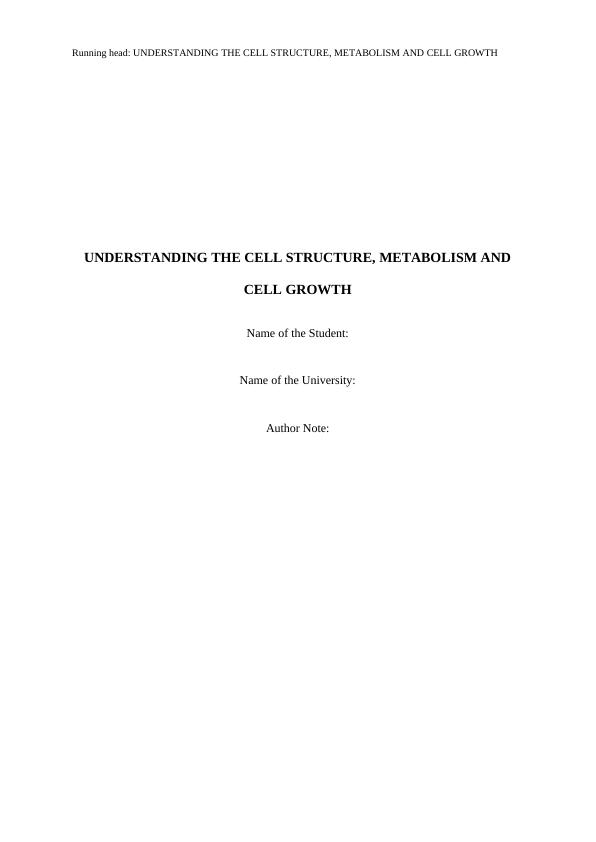
CELL STRUCTURE, METABOLISM AND CELL GROWTH1
Introduction
The cell is the membrane-bound unit that contains the main functional molecules of life.
Living organelles are present in the cell, and it helps in the building blocks of molecular
organisms like humans and other animals. The animal body or the plant body is composed of
fundamental functional units known as microscopic cells. A number of organisms are made
of single-cell; on the other hand, multicellular organisms are composed of multiple cells. A
single-cell organism is known as unicellular or acellular such as amoeba, Chlamydomonas,
and Acetabidaria. Typically, cells are classified into three main types: stem cells, post-mitotic
cells, and dedifferentiated cells (Anderson, 2015, p. 1723). Differentiated cells are
specialized, which return to the undifferentiated zone to take over the work of the division.
Dedifferentiation helps in healing the wounds and vegetative propagation in cells. Eukaryotes
are multicellular, have a cell of size between 5-100 μm. Among all cells, muscle and nerve
cells are comparatively larger. In the case of plants, algae contain large cells as compared to
others. Typically eggs are large size cells that provide food for the development of the
embryo. The human egg is 0.1mm in diameter. Plant cell contains a cell wall and protoplast,
whereas no cell wall is present in the animal cell. It is differentiated into the plasma
membrane, cytoplasm, nucleus, and vacuoles. The cytoplasm is divided into a cytoplasmic
matrix and endoplasmic reticulum (Threadgold, 2017). Cells are generally classified into two
types: Prokaryotic and eukaryotic. Prokaryotes are found in bacteria, and eukaryotes are
observed in plants and animals. A eukaryotic cell contains a nucleus, mitochondria, Golgi
body, endoplasmic reticulum, vacuoles, centriole, vesicle, lysosome, and ribosome. The cell
membrane is present in the eukaryotic cell, which comprises of phospholipids and proteins.
The phospholipid bilayer is found to work as the fluid mosaic model (Turlier, 2018, p. 114).
ATP is the primary energy source of the cell and is produced in the mitochondria. Cell
Introduction
The cell is the membrane-bound unit that contains the main functional molecules of life.
Living organelles are present in the cell, and it helps in the building blocks of molecular
organisms like humans and other animals. The animal body or the plant body is composed of
fundamental functional units known as microscopic cells. A number of organisms are made
of single-cell; on the other hand, multicellular organisms are composed of multiple cells. A
single-cell organism is known as unicellular or acellular such as amoeba, Chlamydomonas,
and Acetabidaria. Typically, cells are classified into three main types: stem cells, post-mitotic
cells, and dedifferentiated cells (Anderson, 2015, p. 1723). Differentiated cells are
specialized, which return to the undifferentiated zone to take over the work of the division.
Dedifferentiation helps in healing the wounds and vegetative propagation in cells. Eukaryotes
are multicellular, have a cell of size between 5-100 μm. Among all cells, muscle and nerve
cells are comparatively larger. In the case of plants, algae contain large cells as compared to
others. Typically eggs are large size cells that provide food for the development of the
embryo. The human egg is 0.1mm in diameter. Plant cell contains a cell wall and protoplast,
whereas no cell wall is present in the animal cell. It is differentiated into the plasma
membrane, cytoplasm, nucleus, and vacuoles. The cytoplasm is divided into a cytoplasmic
matrix and endoplasmic reticulum (Threadgold, 2017). Cells are generally classified into two
types: Prokaryotic and eukaryotic. Prokaryotes are found in bacteria, and eukaryotes are
observed in plants and animals. A eukaryotic cell contains a nucleus, mitochondria, Golgi
body, endoplasmic reticulum, vacuoles, centriole, vesicle, lysosome, and ribosome. The cell
membrane is present in the eukaryotic cell, which comprises of phospholipids and proteins.
The phospholipid bilayer is found to work as the fluid mosaic model (Turlier, 2018, p. 114).
ATP is the primary energy source of the cell and is produced in the mitochondria. Cell
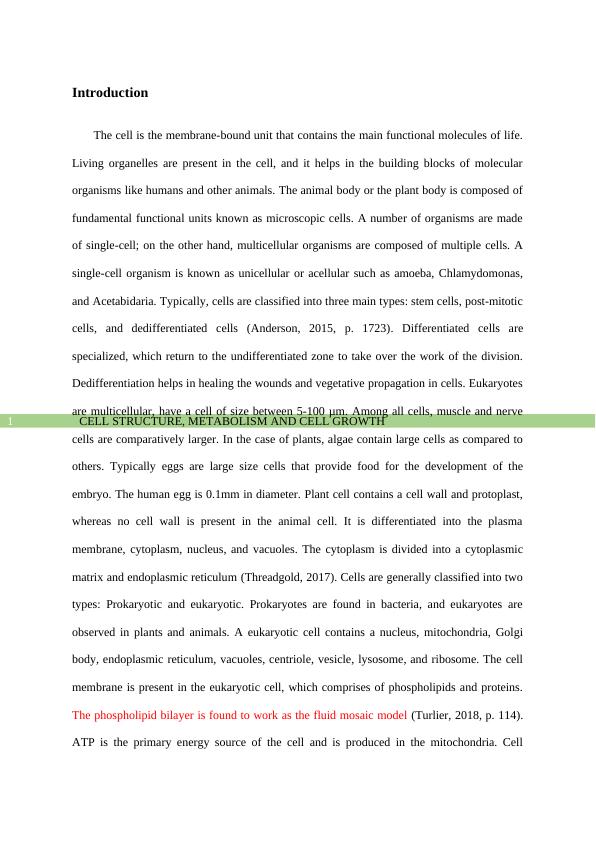
CELL STRUCTURE, METABOLISM AND CELL GROWTH2
metabolism refers to the different set of chemical reactions, which occurs in the cell. Cell
gain nutrients and energy from the food that is consumed by the animal. Foods are digested in
the animal body through different organelles, which provide nutrients to the cell. Cell
division is significant, and it is fragmented into some phases: G1 phase, S phase, G2 phase,
and M phase (mitosis and cytokinesis).
Discussion
Section 1
Living cells have eight important characteristics. First, ingestion is a system to absorb
through cell boundaries or chemical release in the regions. Two, assimilation, is a system in
which a series of conversions of ingested food into the chemical substances takes place,
which is referred to become a biochemical pathway. The release of energy converted into
ATP is an example of assimilation. Third, growth, which is the result of assimilation that
occurs through repairing the parts of the body (Shrimal, 2019, p. 288). Fourth, reproduction
means the production of more individual cells like self. Fifth, elimination refers to the release
of the unused materials or toxic substances, which are converted into molecules by the cell.
Sixth, Responsiveness means to respond to the environment that is a type of reaction.
Seventh, coordination is a complex metabolic reaction that happens with the inhibitors.
Characteristics Prokaryotic Eukaryotic
Nucleus Absent Present
Cell type Normally unicellular Normally multicellular
metabolism refers to the different set of chemical reactions, which occurs in the cell. Cell
gain nutrients and energy from the food that is consumed by the animal. Foods are digested in
the animal body through different organelles, which provide nutrients to the cell. Cell
division is significant, and it is fragmented into some phases: G1 phase, S phase, G2 phase,
and M phase (mitosis and cytokinesis).
Discussion
Section 1
Living cells have eight important characteristics. First, ingestion is a system to absorb
through cell boundaries or chemical release in the regions. Two, assimilation, is a system in
which a series of conversions of ingested food into the chemical substances takes place,
which is referred to become a biochemical pathway. The release of energy converted into
ATP is an example of assimilation. Third, growth, which is the result of assimilation that
occurs through repairing the parts of the body (Shrimal, 2019, p. 288). Fourth, reproduction
means the production of more individual cells like self. Fifth, elimination refers to the release
of the unused materials or toxic substances, which are converted into molecules by the cell.
Sixth, Responsiveness means to respond to the environment that is a type of reaction.
Seventh, coordination is a complex metabolic reaction that happens with the inhibitors.
Characteristics Prokaryotic Eukaryotic
Nucleus Absent Present
Cell type Normally unicellular Normally multicellular
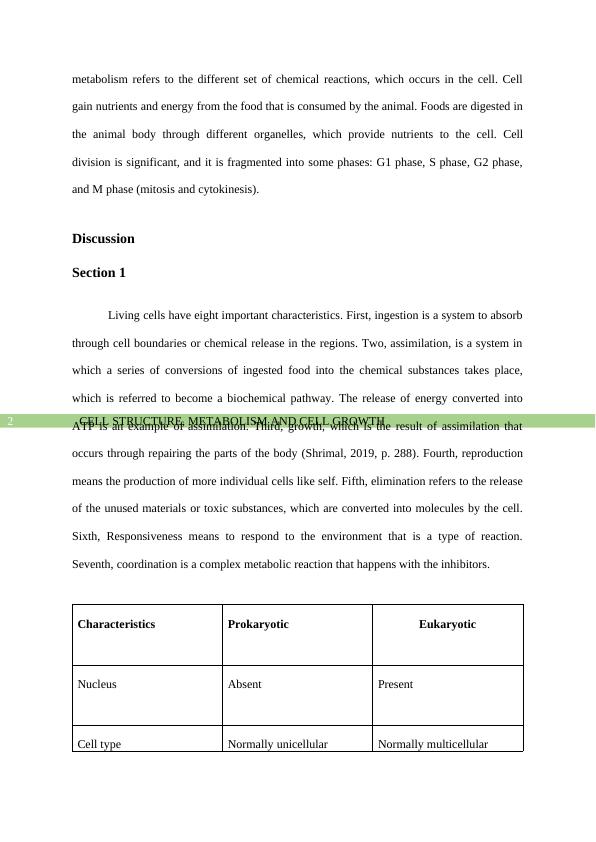
CELL STRUCTURE, METABOLISM AND CELL GROWTH3
Membrane-bound nucleus Absent Present
Genetics Partial transfer Meiosis
Fusion of gametes
Example Archaea
Bacteria
Plant
Animal
Microtubules Absent Present
Mitochondria Absent Present
Endoplasmic reticulum Absent Present
Lysosomes and peroxisomes Absent Present
Cytoskeleton Absent/Rare Present
Ribosomes Smaller (70s) Larger (80s)
DNA wrapping on Proteins Different proteins react with Eukaryotes are wrapped
Membrane-bound nucleus Absent Present
Genetics Partial transfer Meiosis
Fusion of gametes
Example Archaea
Bacteria
Plant
Animal
Microtubules Absent Present
Mitochondria Absent Present
Endoplasmic reticulum Absent Present
Lysosomes and peroxisomes Absent Present
Cytoskeleton Absent/Rare Present
Ribosomes Smaller (70s) Larger (80s)
DNA wrapping on Proteins Different proteins react with Eukaryotes are wrapped
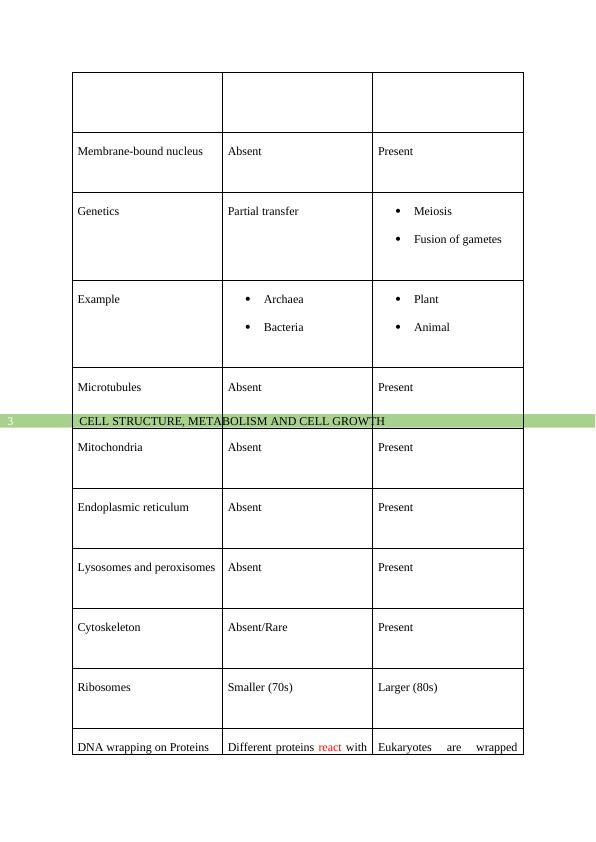
CELL STRUCTURE, METABOLISM AND CELL GROWTH4
each other to fold the DNA
or genetic material and
condense prokaryotic DNA
or prokaryotic genetic
material.
their DNA or genetic
material around the proteins,
and that protein is known as
histone.
Golgi Apparatus Absent Present
Chloroplast The Chloroplast is absent,
and chlorophyll spread
within the cytoplasm.
It is observed in plants.
Cell wall Present. Present in plant cells and a
simpler form.
Cell size 1-10um 10-100um
Membrane permeability Absent Selective
Table 1: Difference between prokaryotic and eukaryotic cell
Source: (Marinov, 2016, p. 667)
each other to fold the DNA
or genetic material and
condense prokaryotic DNA
or prokaryotic genetic
material.
their DNA or genetic
material around the proteins,
and that protein is known as
histone.
Golgi Apparatus Absent Present
Chloroplast The Chloroplast is absent,
and chlorophyll spread
within the cytoplasm.
It is observed in plants.
Cell wall Present. Present in plant cells and a
simpler form.
Cell size 1-10um 10-100um
Membrane permeability Absent Selective
Table 1: Difference between prokaryotic and eukaryotic cell
Source: (Marinov, 2016, p. 667)
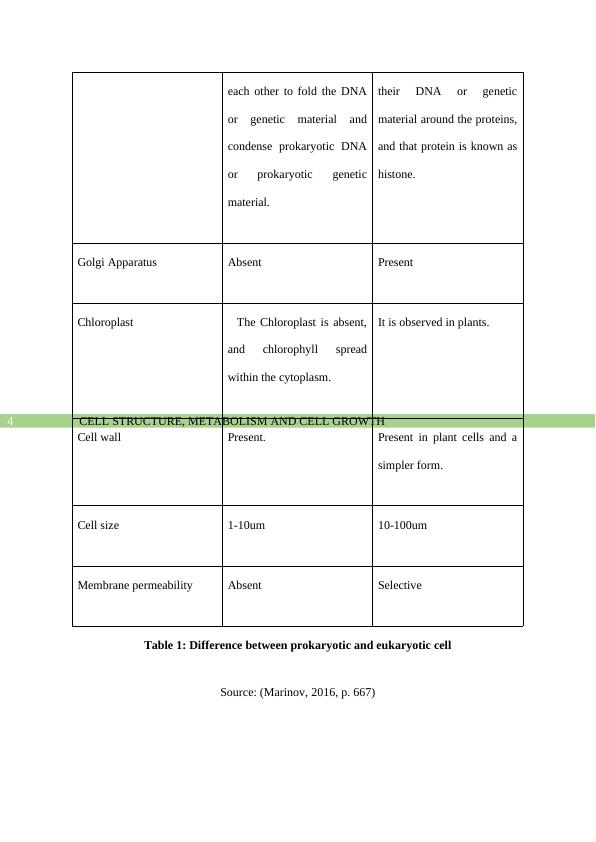
CELL STRUCTURE, METABOLISM AND CELL GROWTH5
Viruses are never considered as neither eukaryotes nor prokaryotes because they have
no characteristics like that of living things. However, they can replicate within liv
(Bellincampi, 2014) (Bellincampi, 2014)ing organisms because, due to lack of eukaryotic cell
or prokaryotic cell, they cannot replicate and reproduce outside of the living cell. Two
microbiologists, Schleiden and Schwann, who demonstrated the structure and characteristics
of cells, described cell theory in 1839. The cell wall is a rigid layer, which is also a non-living
being found outside of the cell membrane. Cell walls are observed in plants, fungi, and
bacteria (Bellincampi, 2014, p. 228). In the case of a plant, cellulose is the primary
component of the cell wall. There are three layers present which supports and helps the plant
as a structural framework. The cell wall gives plant cells an equal shape and offers support to
the plant body.
Figure 1: Structure of the living cell
The plasma membrane is another name of the cell membrane. Cell membrane divides
the intracellular space from the outer environment (outer part of the cell) and is present in
both plant cell and animal cell. The cell membrane surrounds the cytoplasm and helps in
Viruses are never considered as neither eukaryotes nor prokaryotes because they have
no characteristics like that of living things. However, they can replicate within liv
(Bellincampi, 2014) (Bellincampi, 2014)ing organisms because, due to lack of eukaryotic cell
or prokaryotic cell, they cannot replicate and reproduce outside of the living cell. Two
microbiologists, Schleiden and Schwann, who demonstrated the structure and characteristics
of cells, described cell theory in 1839. The cell wall is a rigid layer, which is also a non-living
being found outside of the cell membrane. Cell walls are observed in plants, fungi, and
bacteria (Bellincampi, 2014, p. 228). In the case of a plant, cellulose is the primary
component of the cell wall. There are three layers present which supports and helps the plant
as a structural framework. The cell wall gives plant cells an equal shape and offers support to
the plant body.
Figure 1: Structure of the living cell
The plasma membrane is another name of the cell membrane. Cell membrane divides
the intracellular space from the outer environment (outer part of the cell) and is present in
both plant cell and animal cell. The cell membrane surrounds the cytoplasm and helps in

CELL STRUCTURE, METABOLISM AND CELL GROWTH6
protecting the cytoplasm. The cytoplasm is present in the protoplasm. The cell membrane is
composed of the lipid bilayer, which is also called as phospholipids. Phospholipids are
composed of a hydrophilic head and a hydrophobic tail. The hydrophilic head is water-
loving, and the hydrophobic means water avoiding, the hydrophobic tail is water avoiding
(Goni, 2014, p. 1467). The polar parts try to create hydrogen bonds with water, while the
non-polar tails try to get away from the water and water solution. This problem is resolved
through the creation of a bilayer because the hydrophilic heads can target outwards and create
hydrogen bonds with water, and the hydrophobic tails focus towards one another and are
protected from the water molecules.
Figure 2: Structure of the cell membrane
The transfer between the cell and its environment has to go through the cell
membrane. The cell membrane is specifically permeable to few specific ions, small
molecules, and larger molecules and controls the motion of substances. Many functions such
as diffusion, osmosis, transport of nutrients are performed within the cell (Encarnacao, 2017,
p. 400). The cell membrane is strong and flexible in nature. It provides support to the cell
and flexibility, thus, helps to grow and move. S.J. Singer and G.L. Nicolson discovered the
protecting the cytoplasm. The cytoplasm is present in the protoplasm. The cell membrane is
composed of the lipid bilayer, which is also called as phospholipids. Phospholipids are
composed of a hydrophilic head and a hydrophobic tail. The hydrophilic head is water-
loving, and the hydrophobic means water avoiding, the hydrophobic tail is water avoiding
(Goni, 2014, p. 1467). The polar parts try to create hydrogen bonds with water, while the
non-polar tails try to get away from the water and water solution. This problem is resolved
through the creation of a bilayer because the hydrophilic heads can target outwards and create
hydrogen bonds with water, and the hydrophobic tails focus towards one another and are
protected from the water molecules.
Figure 2: Structure of the cell membrane
The transfer between the cell and its environment has to go through the cell
membrane. The cell membrane is specifically permeable to few specific ions, small
molecules, and larger molecules and controls the motion of substances. Many functions such
as diffusion, osmosis, transport of nutrients are performed within the cell (Encarnacao, 2017,
p. 400). The cell membrane is strong and flexible in nature. It provides support to the cell
and flexibility, thus, helps to grow and move. S.J. Singer and G.L. Nicolson discovered the

CELL STRUCTURE, METABOLISM AND CELL GROWTH7
Fluid Mosaic Model of the cell membrane. Fluid Mosaic Model demonstrates the basic
structure of the cell membrane as a fluid-structure with different protein components and
carbohydrate compounds diffusing across the membrane (Nicolson, 2014, p. 1451).
Figure 3: Phospholipid bilayer
Cell membrane proteins are found crossing the membrane from the inner division to
the outer division of the cell. The membrane proteins consist of a hydrophilic and
hydrophobic area, which allow proteins to pass suitable into the cell membrane. Membrane
protein works as a carrier protein and restricts the motion of the ion and molecule over the
cell membrane. Glycoproteins are observed on the extracellular space of the cell membrane,
which is also linked to polypeptide chains. It the case of a cell-to-cell recognition,
glycoproteins are used and is most) suitable (Anderson, 2015, p. 1723) Glycolipids are
attached to phospholipids on the outer surface of the cell membrane. It works as the
recognition site for specified chemicals and is important in cell-to-cell linkage to form
tissues. The motion of substances over cell membranes is hugely beneficial as it allows cells
to obtain oxygen and nutrients, remove waste products, and control the number of required
substances in the cell. The significant processes by which such motion and transportation take
place include diffusion, osmosis, facilitated diffusion, and active transport (Ayala, 2014, p.
3).
Fluid Mosaic Model of the cell membrane. Fluid Mosaic Model demonstrates the basic
structure of the cell membrane as a fluid-structure with different protein components and
carbohydrate compounds diffusing across the membrane (Nicolson, 2014, p. 1451).
Figure 3: Phospholipid bilayer
Cell membrane proteins are found crossing the membrane from the inner division to
the outer division of the cell. The membrane proteins consist of a hydrophilic and
hydrophobic area, which allow proteins to pass suitable into the cell membrane. Membrane
protein works as a carrier protein and restricts the motion of the ion and molecule over the
cell membrane. Glycoproteins are observed on the extracellular space of the cell membrane,
which is also linked to polypeptide chains. It the case of a cell-to-cell recognition,
glycoproteins are used and is most) suitable (Anderson, 2015, p. 1723) Glycolipids are
attached to phospholipids on the outer surface of the cell membrane. It works as the
recognition site for specified chemicals and is important in cell-to-cell linkage to form
tissues. The motion of substances over cell membranes is hugely beneficial as it allows cells
to obtain oxygen and nutrients, remove waste products, and control the number of required
substances in the cell. The significant processes by which such motion and transportation take
place include diffusion, osmosis, facilitated diffusion, and active transport (Ayala, 2014, p.
3).

End of preview
Want to access all the pages? Upload your documents or become a member.
Related Documents
Cell Biology and Biochemistrylg...
|8
|2140
|1
Functions of Cell Parts, Multicellular Organisms, and Neuron Cell Structure and Functionlg...
|9
|1955
|449
The structure of the cell. 9 The structure of the celllg...
|14
|2919
|55
Compartmentalization of cells PDFlg...
|4
|833
|241
Analogy between organelles in eukaryotic and prokaryotic cells and comparison with factory partslg...
|3
|928
|161
Assignment: Observation of general structures of a plant celllg...
|8
|1580
|121
